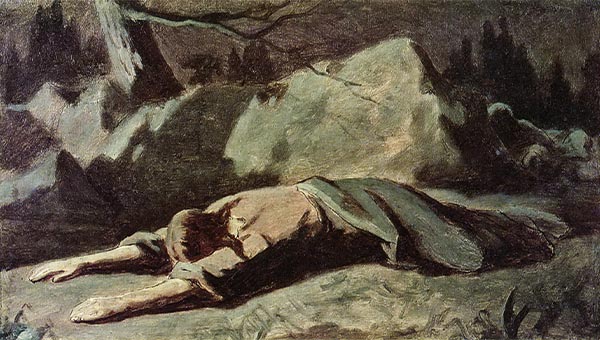Subtotal: $
Checkout
Jesus and the Temptation to Violence
Even during his last hours in Gethsemane, Jesus was tempted to take up the sword, but ultimately he rejected the way of violence.
By André Trocmé
March 6, 2022
Available languages: Español
From Jesus and the Nonviolent Revolution by André Trocmé.
Jesus was not exempt from being tempted by the solution of force. One gets the distinct feeling that Jesus was on the verge of making a warlike decision when he exclaimed that he would cast fire upon the earth and swing the sword that brings division: “Do you think I came to bring peace on earth? No, I tell you, but division. From now on there will be five in one family divided against each other, three against two and two against three. They will be divided, father against son and son against father, mother against daughter and daughter against mother, mother-in-law against daughter-in-law and daughter-in-law against mother-in-law” (Luke 12:49–53). Jesus understood well that God’s rulership would first require upheaval. In some way or another it would have to be taken by force.
At one point Jesus said, “From the days of John the Baptist until now, the kingdom of heaven has been forcefully advancing, and forceful men lay hold of it” (Matt. 11:12). However one chooses to interpret these words, they still reveal Jesus’ sympathy for “forceful” people. According to some interpreters, this passage means that Jesus thought only those with a violent character could force the door to the kingdom of God and become its heroes. Jesus’ disciples were to be combatants who would fight for Israel’s independence like the Zealots. According to others, Jesus’ words are actually a warning against those who want to establish the kingdom of God by violence. Regardless, they reveal a profound irritation with the “lukewarm,” who think that one can enter the kingdom of God without struggle.
Toward the end of his life, the temptation toward violence only increased. Jesus vented his indignation toward the scribes and Pharisees by calling divine vengeance upon them (Matt. 23). The parables he employed almost all conclude with violence. Some tenants revolt against the heir of the vineyard, and Jesus said, “He [the master] will bring those wretches to wretched end” (Matt. 21:41). Of those who had been invited to attend the wedding feast of the king’s son but refused, Jesus remarked, “The king was enraged and he sent his army and destroyed those murderers and burned their city.” This same king tells his servants, “Tie him [the man who had no wedding garment] hand and foot and throw him outside into the darkness, where there will be weeping and gnashing of teeth” (Matt. 22:7, 13).
One could argue that these are only parables, imagery used to make an impression on the listeners and bring them to repentance. But to destroy corrupt customs that turned the temple into a marketplace, Jesus took a whip of cords and chased out those who sold and bought in the temple. He overturned the tables of the money‑changers and the seats of those who sold pigeons and said, “My house will be called a house of prayer, but you are making it a den of robbers” (Matt. 21:13).
The temptation to use violence accompanied Jesus right to his death. A few hours before his arrest he went so far as to reverse his earlier instructions concerning absolute poverty and meekness. “But now if you have a purse, take it, and also a bag; and if you don’t have a sword, sell your cloak and buy one.” When his disciples said, “See, Lord, here are two swords,” he told them, “That is enough” (Luke 22:36–38). Beyond these two paltry human weapons, Jesus knew he could count on the help of twelve legions of angels ready to intervene at a moment’s notice. It was only after an intense inner struggle, after the genuine moral agony at Gethsemane, that Jesus finally rejected resorting to violence.

Vasily Perov, Christ in Gethsemane (Public domain)
Jesus was no theorist of nonviolence. He overcame violence by a succession of day‑to‑day decisions and a series of redemptive acts. On every occasion, he freely chose the road of nonviolence rather than that of armed resistance. Jesus’ refusal to use force was therefore not some extra‑historical dream of a mystic trying to forget the concrete realities of this world. He did not ignore the human condition. His way was a step‑by‑step journey through the obstacles, mountain passes, snares, and cliffs of history. Jesus carved a new path into the hardness of human realities, a path he trod first, carrying on his shoulders the way of the cross and all the requirements of the kingdom of God: social justice, radical transformation, commitment to truth, and personal regeneration. These are the materials with which he builds the kingdom of God.
Consequently, the chastisement deserved by the hypocritical Pharisees, the jealous Sanhedrin, the cowardly Pilate, and the fickle crowd fell back on him. Jesus deliberately chose to be crucified. He took responsibility for the apparent failure of his mission. But his sacrifice was not a capitulation. For since that event, no man, no nation, no party, no head of state, whether a believer or an unbeliever, can forget Christ. No one can honestly ignore the fact that it was God himself who was nailed to the cross with our injustices and crimes. …
Jesus stood between – and, in the end, beyond – the options of violence or withdrawal, fight or flight. As tempting as these options were, he chose another way. This does not mean he refused to play a historical role. We must not imagine him as a sublime yogi sheltered from the world on the shores of eternity, or as an ascetic who invited his disciples to follow him in solitude in order to learn an ideal having no connection whatsoever with the problems of this world. …
Jesus overcomes the world not by condemning it, but by saving it (John 3:16–18). He does not offer us an abstract kingdom of ideas, but redemptive actions of healing and liberation. Jesus came from God and returned to God, but only after having planted the seeds of the future: the kingdom on this earth. And Jesus the Messiah will return, because his final aim is to save the entire cosmos. There will be redemption, not just for individuals, but for the whole world. His kingdom will come fully to the earth, just as it is in heaven.
Jesus rejected the way of violence. He overcame his enemies without using the methods common to the kingdoms of this world. His way would be the cross. And yet this way was not one of passive resignation or of avoiding conflict. To inaugurate his triumph as a peaceable king, he entered Jerusalem, the heart of humanity’s anguish and longing. And he did so free from the temptations of coercion and withdrawal. Followed by the long procession of his disciples, Jesus made his entry into the history of each nation and of each century, and continues to do so through his people until the day when his victory is complete.
Already a subscriber? Sign in
Try 3 months of unlimited access. Start your FREE TRIAL today. Cancel anytime.







Bruce Hollenbach
There is a completely different way to read Luke 22:35-38, which I believe gives this passage more coherence: Luke 22:35 -- Jesus reminds his disciples that when they went out on mission before, they experienced no need of provisions. Luke 22:36 -- Jesus says to them, 'But now [I hear you saying to one another], "if you have a purse, take it, and also a bag," and "if you don't have a sword, sell your cloak and buy one." [Why this? What has changed?] Luke 22:37 -- [You need to remember that] It is written: 'And he was numbered among the transgressors', and I tell you that this must be fulfilled in me. Yes what is written about me is reaching its fulfillment. [So there is no need for you to defend me from the consequences.]' Luke 22:38 -- (The disciples don't understand at all what Jesus is saying. So) The disciples said, "See, Lord, here are two swords." "That is enough," he replied. (Jesus realizes that he is not getting through to these ignorant men, and so he terminates the conversation. He is not saying, "Two swords will be all we need." He is saying, "This talk is getting us nowhere. Stop it now.")